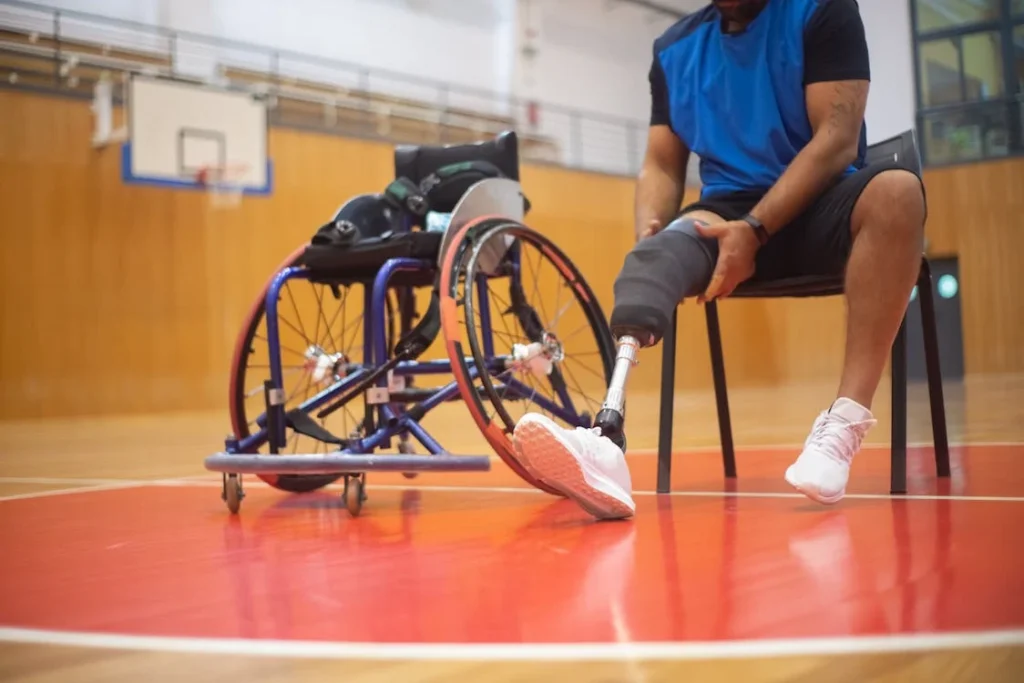When someone starts using a lower limb prosthetic, most people focus on the mechanics. Will it help them walk again? Will it fit right? Will it hold up over time? But one of the most important and often overlooked parts of the experience is how the prosthetic feels on the skin—every single day.
Even the best prosthetic in the world can become unbearable if it causes pain, blisters, or sores. That’s because the skin on our residual limbs isn’t made to handle constant rubbing or pressure. When this happens, it can lead to something called skin breakdown. This doesn’t just hurt—it can stop someone from wearing their prosthetic at all, forcing them back into a wheelchair or bed until they heal.
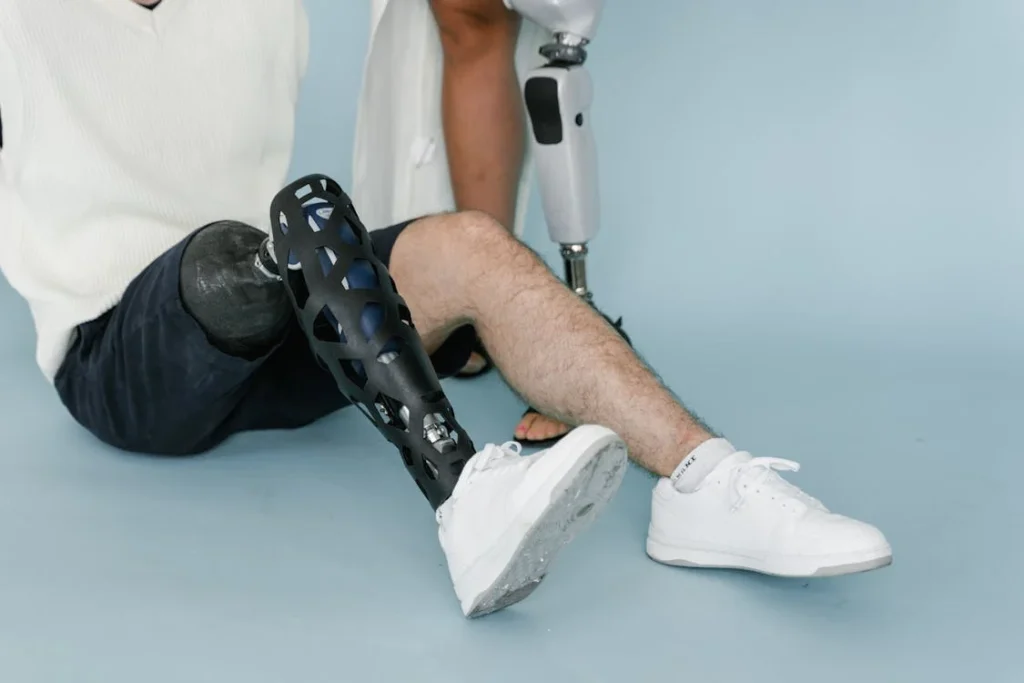
Understanding Pressure Points in Lower Limb Prosthetics
What Are Pressure Points and Why Do They Matter?
A pressure point is a small area on your residual limb where the prosthetic socket pushes harder than it should. These points aren’t just uncomfortable—they can become dangerous over time.
When too much pressure is focused on one spot, the skin can become red, irritated, and eventually break down. If it isn’t treated, it can lead to open wounds, infections, and a painful recovery.
Skin breakdown isn’t something to take lightly. Once it starts, it can keep coming back, especially if the cause isn’t fixed.
That’s why it’s so important to understand where these pressure points come from and how to deal with them before they get worse.
How Pressure Builds in a Prosthetic Socket
When you walk or stand, your weight moves through your body and into your residual limb. The prosthetic socket is supposed to spread that pressure across the limb evenly.
But sometimes, the fit isn’t perfect. This could be because the socket is too tight in one area, or the shape of your limb has changed over time. Even small shifts can cause big problems.
Pressure can also build up because of movement. As you walk, your skin rubs against the inside of the socket. This friction adds to the problem. When friction and pressure combine, they can damage the skin much faster.
Sweat and heat inside the socket make things worse. Moist skin is more likely to break down. So, on a hot day or after a long walk, pressure points can turn into blisters or sores if not managed properly.
Common Areas Where Pressure Points Develop
Not every limb is the same, but some pressure points show up in similar spots for many people. For above-knee users, it’s often near the end of the limb or around bony areas like the femur.
For below-knee users, it could be around the tibia or the back of the knee. These areas have less padding from muscle and fat, so they take more of the force from the socket.
Sometimes the issue isn’t where you feel pain but somewhere else. For example, if your socket is too loose, your limb may slide and cause pressure on the opposite side.
That’s why it’s important to look at the whole picture, not just where it hurts.
Early Signs of Skin Trouble You Should Never Ignore
Most people know what pain feels like. But with pressure points, the signs often start small. You might notice a red patch after taking off your prosthetic.
Maybe there’s a sore spot that goes away overnight. But when these signs show up again and again, they’re trying to tell you something.
Don’t ignore small skin changes. If your skin stays red for more than 20–30 minutes, it means there’s too much pressure.
If the skin feels hot or itchy, that’s a sign of irritation. If a bump, blister, or open sore forms, it’s time to act immediately.
Even if you don’t feel much discomfort, check your skin every day—especially if you have reduced sensation in your limb.
Use a mirror if needed or ask someone to help. Skin issues can build up quietly, and by the time they hurt, they might already be serious.
Why the Right Socket Fit Is the First Step to Comfort
The socket is the part of the prosthetic that wraps around your limb. It’s custom-made to match your shape, but your body isn’t made of metal or plastic—it changes.
Your limb may shrink, swell, or shift slightly depending on the time of day, how active you are, or your overall health. That’s why a socket that fit perfectly a few months ago might not feel the same today.
If your socket is too tight, it creates high-pressure zones. If it’s too loose, your limb might rub or move too much.
Either way, the result can be skin breakdown. That’s why regular check-ins with your prosthetist are so important. They can adjust the socket, add padding, or recommend new liners to help improve the fit.
Keeping a journal of how your limb feels throughout the day can also help. Write down when you feel discomfort, where it happens, and what you were doing.
This can help your prosthetist understand the root of the problem faster and make better changes.
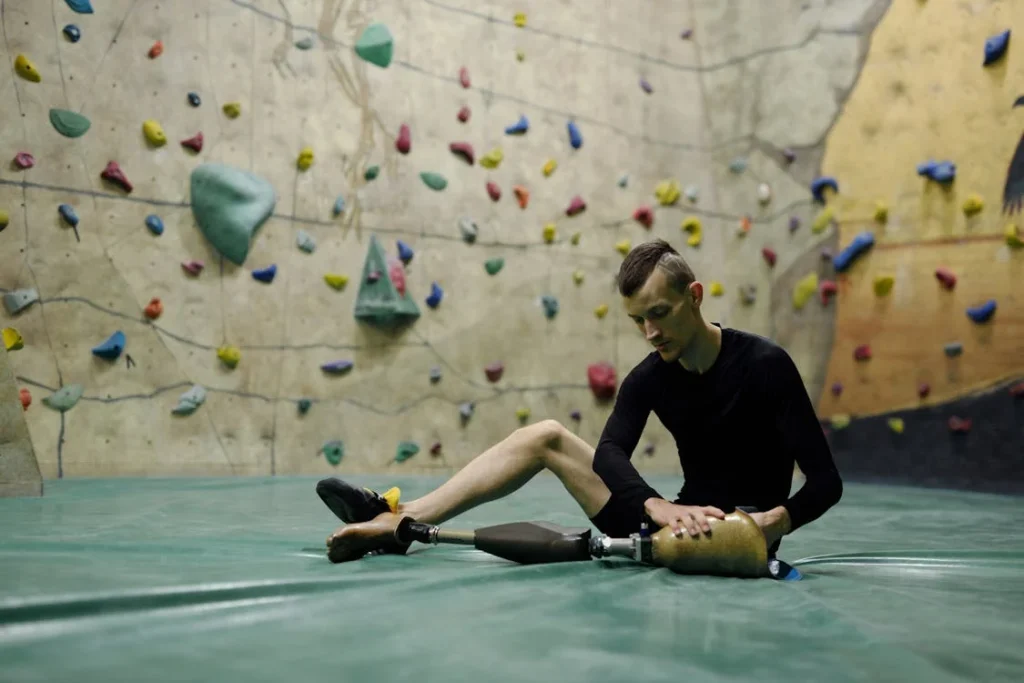
How to Prevent Skin Breakdown Before It Starts
Building Good Habits From Day One
Preventing skin problems is much easier than treating them later. The key is building small daily habits that protect your skin and keep pressure points from turning into serious wounds.
Start with checking your limb every single day. Even if it looks fine, give it a closer look. Use your fingers to feel for any warm spots, raised bumps, or hard skin.
If your skin looks red, sore, or different in any way, take a break from wearing your prosthetic and let your skin rest. A short break now can save you weeks of recovery later.
Cleaning your skin daily is also important. Use mild soap and warm water. Avoid hot water or anything with strong perfumes.
After washing, make sure your skin is completely dry before putting your prosthetic back on. Damp skin trapped inside a socket is a breeding ground for bacteria.
And don’t forget your liner or socks—they touch your skin all day. These should be cleaned after every use. If they smell, feel stiff, or look dirty, wash them right away or replace them.
Managing Sweating and Moisture Inside the Socket
Sweat can cause major skin problems. It increases friction, weakens the skin, and creates heat and moisture that can irritate the skin even more. It’s one of the most common reasons pressure points get worse.
Some people sweat more than others, and that’s okay. What matters is how you handle it. Try using moisture-wicking liners or prosthetic socks made to pull sweat away from the skin.
These help keep the area dry and reduce rubbing.
In hot weather or after physical activity, take off your prosthetic for a few minutes if possible. Let the skin breathe. Pat the limb dry with a soft towel before putting it back on.
There are also skin-safe antiperspirant sprays made just for prosthetic users. Talk to your prosthetist before trying these, as some products can dry out the skin too much or cause allergic reactions.
When the Socket Isn’t the Only Problem
Sometimes the pressure isn’t coming from the socket at all. Your gait—or the way you walk—can also cause uneven forces on your limb. If your walking pattern is off, it can shift pressure in ways that harm the skin over time.
You might not notice these changes, but a trained eye can. If you’re limping, favoring one side, or putting more weight on a certain part of your limb, these are signs that your prosthetic alignment or walking style needs attention.
This is why rehabilitation is such an important part of the journey. Working with a trained physical therapist or prosthetic specialist can help you develop healthy movement habits that take pressure off the wrong spots and spread the load evenly across your limb.
Rehabilitation isn’t just for new users. Even experienced users benefit from occasional retraining—especially after surgery, illness, or a long break from using the prosthetic.
How to Know When It’s Time for an Adjustment
No prosthetic stays perfect forever. Your body will change, and your needs will shift. Knowing when to ask for help is just as important as any daily habit.
Here are a few signs you might need a socket adjustment:
- You feel pressure or pain in a new spot.
- The limb moves or rotates inside the socket when walking.
- You find yourself using extra padding more often.
- The skin looks irritated in the same place repeatedly.
You don’t need to suffer through discomfort. A small adjustment early on can save you from long-term skin damage.
Regular visits with your prosthetist, even when things seem fine, are the best way to stay ahead of problems.
A well-fitting socket should feel snug but not tight, secure but not stiff. If it starts to feel different, trust your instincts and get it checked.
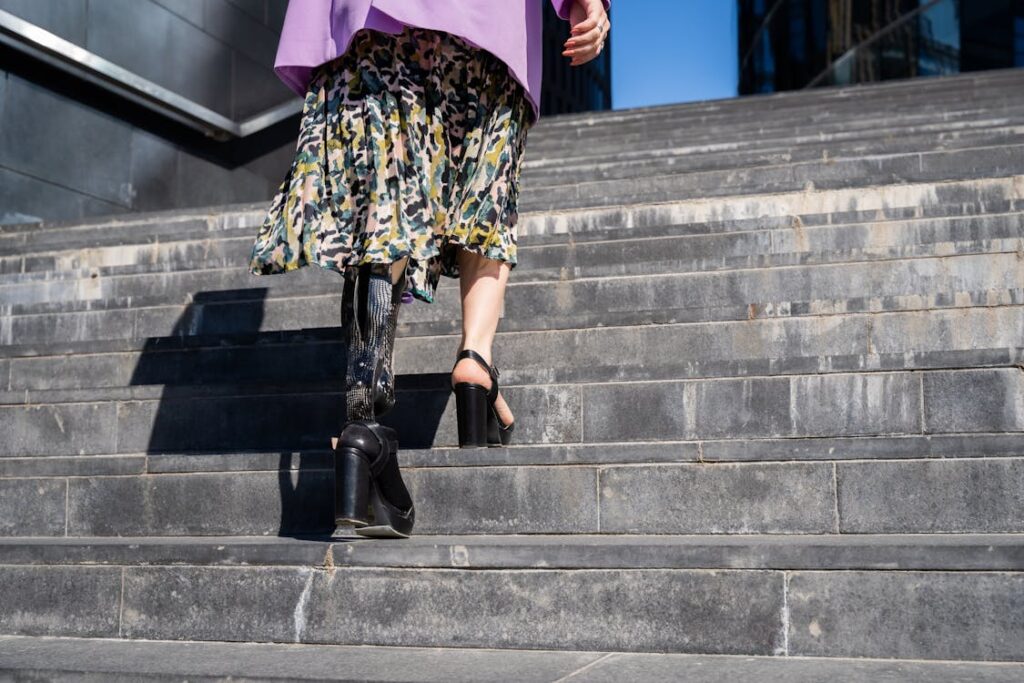
The Role of Liners, Socks, and Suspension in Pressure Management
Understanding the Layers Between Skin and Socket
Your limb doesn’t sit bare inside the hard shell of the socket. There are layers in between—like liners, prosthetic socks, or gel sleeves—that protect your skin, improve comfort, and help the socket fit better. These layers play a big role in controlling pressure points.
A liner is usually made from silicone, gel, or foam. It wraps around your residual limb and cushions it inside the socket. Good liners absorb shock and reduce friction.
But not all liners are created equal. Some are thicker and softer, while others are thinner for more control. Choosing the right liner depends on your activity level, skin sensitivity, and limb shape.
If your skin is sensitive or prone to breakdown, a softer liner may help reduce direct pressure. But a liner that’s too soft can cause your limb to shift inside the socket, creating other problems.
It’s a balance, and that’s why working closely with your prosthetist to find the right type of liner is so important.
Prosthetic socks help adjust the fit when your limb volume changes. Throughout the day, your limb can swell or shrink. Adding or removing a sock changes how snugly your limb fits inside the socket. If the fit feels too loose or tight, don’t just keep walking—try adding or removing a sock layer.
But layering too many socks can create uneven pressure. If you need more than two or three sock layers to get a good fit, it may be time to get your socket re-evaluated.
Suspension Systems and Skin Safety
The suspension system keeps your prosthetic limb attached to your body. It might use a vacuum seal, a pin lock, suction, or straps. Each type of suspension puts different kinds of force on your skin.
If your suspension isn’t working right, your limb may move inside the socket, leading to rubbing and pressure points. Or the socket might press too hard in one area to stay in place, which causes soreness over time.
For example, with a pin lock system, the end of your limb may be pulled down with each step. If the liner doesn’t fit properly, it can create pressure at the tip of your limb—often leading to sores in that area.
A vacuum system, on the other hand, pulls your limb evenly into the socket using air pressure. When it works well, it reduces movement and creates a better seal.
But if there’s a leak or the vacuum isn’t strong enough, it can lose suction and lead to the same problems.
Whatever system you use, make sure it’s functioning properly. Even a small issue—like a worn-out seal or stretched strap—can throw off the fit and increase pressure in the wrong areas.
Seasonal Changes That Affect Fit and Skin
Believe it or not, the time of year can change how your prosthetic feels. Hot weather makes you sweat more, which can soften your skin and make it easier to damage.
Your limb may also swell from heat, changing the way it fits inside the socket. Cold weather can do the opposite—making your skin drier and your limb smaller.
These changes can sneak up on you. One day your prosthetic fits fine, the next it feels off. That’s why it’s helpful to track these patterns.
If you know your limb tends to swell in the summer, you can prepare by using different sock layers or switching to a more breathable liner.
Don’t ignore the signs. If your skin gets itchy, sticky, or irritated during a certain time of year, treat it as a warning. Adjust your routine to prevent small issues from turning into skin breakdown.
How Weight and Diet Affect Limb Volume and Pressure
What you eat and how much you weigh also impact how your prosthetic fits. Gaining or losing even a few kilos can change the shape of your residual limb.
This might make your socket feel tighter or looser, affecting where pressure builds.
A balanced diet helps your body maintain a steady limb volume. Foods high in salt can cause swelling, while dehydration can make your limb shrink. Both affect fit and can create new pressure points overnight.
Weight gain can also affect your gait and posture, putting more pressure on certain areas.
This doesn’t mean you need to diet or lose weight to use a prosthetic—it just means that staying aware of how changes in your body affect your fit is key to protecting your skin.
If you notice consistent changes in how your prosthetic feels, or you’re constantly adjusting socks and padding, talk to your prosthetist. Sometimes a small change in your routine can restore balance.
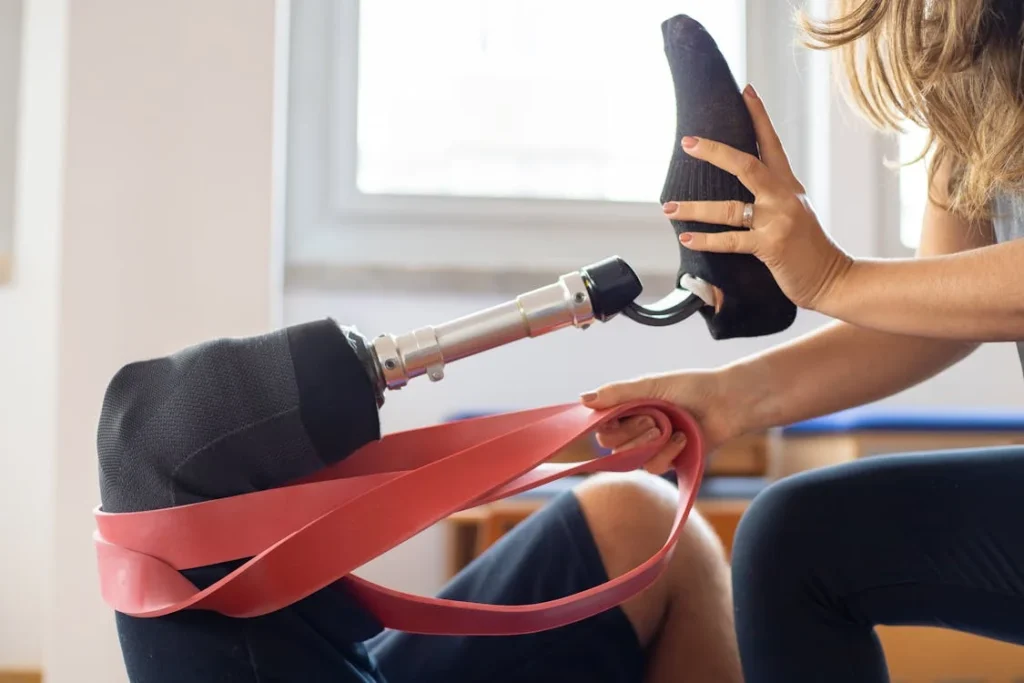
The Importance of Consistent Follow-Ups and Adjustments
Why “Set and Forget” Doesn’t Work in Prosthetics
Getting your first prosthetic socket is a major step, but it’s not the last one. Many people believe that once the socket is made and fits well, the journey is complete. In reality, that’s just the beginning.
Your body continues to adapt and change. Muscles become stronger or weaker, your walking style improves, and your daily activities evolve.
These changes shift how pressure is applied inside the socket. A fit that felt perfect two months ago may now be causing pressure points you don’t notice right away.
This is why regular follow-ups with your prosthetist are critical. These check-ins aren’t just for new users—they’re for anyone who wants to keep using their prosthetic safely and comfortably.
Your prosthetist can spot small issues before they become big problems. They can check for uneven wear on the liner, changes in socket pressure, or early signs of skin irritation.
They might suggest minor tweaks like re-lining, reshaping, or replacing worn-out parts. These small changes make a big difference in keeping pressure even and skin healthy.
What a Good Follow-Up Should Include
When you visit your prosthetist, it’s helpful to go in prepared. Describe exactly what you’ve been feeling—don’t leave out small discomforts.
Even if the skin looks okay, say where you feel rubbing, pinching, or sliding. Your feedback helps guide the adjustment process.
A thorough check-up usually includes:
- Removing your prosthetic and checking the limb for red spots or sore areas.
- Examining the socket for cracks, loose parts, or shape changes.
- Looking at your gait and balance during walking.
- Making sure the suspension system holds firm without shifting.
- Checking liners and socks for wear, thinning, or odor.
It’s also a great time to bring up other concerns—like sweating, socket odor, or changes in activity level. These all affect how your prosthetic fits and performs.
If your lifestyle has changed—say you’ve started walking more or picked up a new hobby—mention it. Your prosthetic setup might need an update to keep up with your needs.
Adapting to New Prosthetics Without Hurting Your Skin
Anytime you receive a new socket, liner, or foot component, it takes time to adjust. The worst thing you can do is wear it all day right from the start. Even if it feels comfortable at first, new pressure patterns can affect your skin gradually.
Start slow. Wear your new setup for a couple of hours, then take it off and check your skin. Look for red patches, dents, or any area that feels sore. If it all looks good, increase the wear time slowly over the next few days.
Rushing the break-in process can create pressure points that spiral into wounds quickly. It’s much better to ease in and avoid setbacks.
Your prosthetist will usually give you a schedule to follow. Stick to it, even if it feels like you’re ready for more.
Your skin needs time to adapt just like the rest of your body. Be patient with it.
What to Do if Skin Breakdown Starts
Sometimes, even with the best care, skin breakdown still happens. Maybe it was a long day on your feet. Maybe the weather changed. Maybe the liner got a wrinkle. The important thing is what you do next.
If you notice a red spot that doesn’t go away after a few hours, give your skin a break. Try not to wear the prosthetic until the area heals.
Use a clean cloth to gently wash the area and keep it dry. If the skin is broken, apply a mild antiseptic and cover it with a sterile bandage.
Don’t apply lotions, powders, or creams unless your doctor tells you to. Many products can make things worse by trapping moisture or causing irritation.
If the sore gets worse, or if you see pus, swelling, or heat, get medical help right away. Infections can spread fast and may require antibiotics.
Never try to push through pain—it can turn a minor issue into a serious health problem.
Also, never return to wearing the same prosthetic setup without addressing the root cause. Talk to your prosthetist to understand what led to the skin damage.
It could be a simple fix—like changing a sock or adjusting the liner. But until it’s fixed, your skin will keep getting hurt in the same place.
Prosthetic Breaks and Rest Days
Just like your legs need rest, so does your skin. It’s okay to take breaks from wearing your prosthetic, especially after long or difficult days.
Give your limb time to recover. If you can, elevate your leg and let it breathe. This helps reduce swelling and gives your skin a chance to repair itself naturally.
On days when you feel skin discomfort or early irritation, choose rest over activity. It may feel frustrating in the moment, but it can save you from being sidelined for much longer due to a sore or wound.
Some users benefit from a backup prosthetic for short-term use while letting the skin recover. Talk to your prosthetist if you experience frequent pressure points—it might be worth exploring.
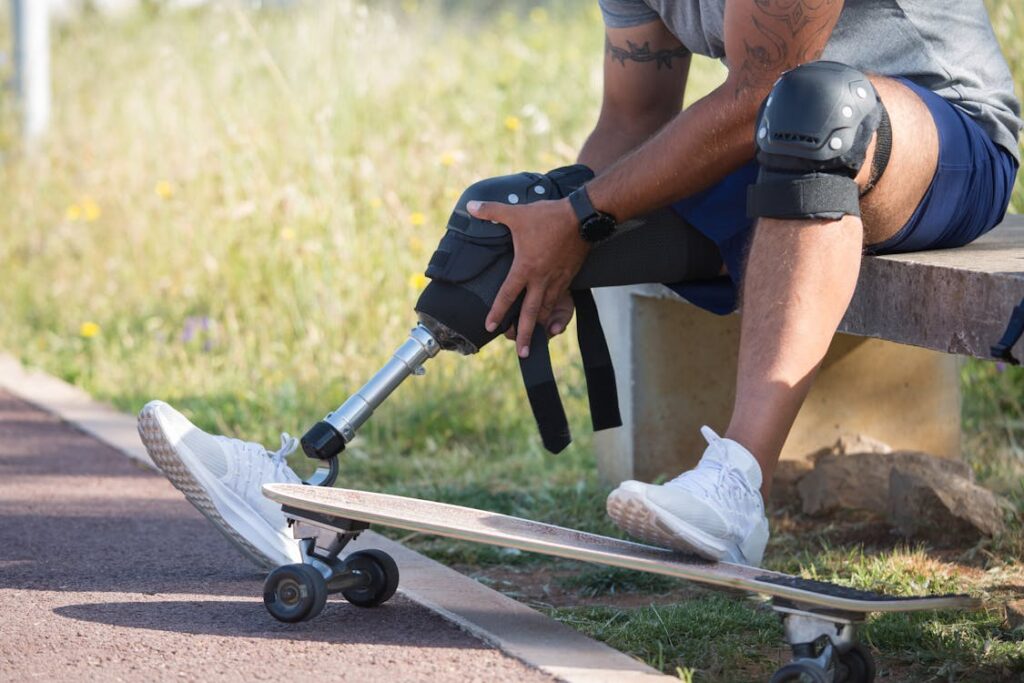
Real-World Tips for Everyday Skin Protection
Start and End Each Day with a Skin Check
One of the most powerful habits you can build is to inspect your residual limb at the start and end of every day. Think of it like brushing your teeth. It doesn’t take long, but it prevents bigger problems later.
In the morning, check your skin before putting on your prosthetic. This helps you catch anything that developed overnight, like swelling or irritation.
If something feels off, don’t rush to put the prosthetic on. Give your limb a few minutes to adjust after you wake up, especially if you’ve been lying down for hours.
At night, after removing the prosthetic, check your skin again. Look for redness, blisters, or dry patches. Pay attention to how your limb feels too.
Warm spots, tenderness, or a dull ache can be early signs of pressure problems.
If you notice the same issue in the same place more than once, it’s time to adjust something—whether it’s your sock layers, liner, or activity level.
Keep Your Skin Strong and Healthy
Healthy skin is your best defense against pressure sores. When your skin is strong, it can handle a little friction or pressure without breaking down.
But when it’s dry, thin, or damaged, even small amounts of pressure can cause problems.
Hydration plays a big role in this. Drink enough water each day to keep your skin naturally moist from the inside.
This helps maintain elasticity and resilience. If your skin tends to be dry, especially in cold seasons, use a simple, fragrance-free moisturizer at night—after cleaning and drying the limb.
During the day, avoid lotions before wearing your prosthetic. They can soften the skin too much or cause slippage inside the socket.
Also, protect your skin from cuts and scratches. Even a small nick can become a serious sore when trapped inside a tight socket.
Be careful when shaving or trimming hair near your limb, and don’t scratch itchy spots with sharp objects.
Wear clean, dry liners and socks. Change them if they get damp. Wash them as directed—usually with mild soap and warm water, then air-dried. Dirty or worn-out materials can irritate the skin and harbor bacteria.
Mind Your Movements and Footing
How you move has a direct effect on pressure distribution. Uneven steps, sudden turns, or limping can cause certain areas of the limb to work harder or absorb more impact than others.
Over time, this adds up and can lead to skin stress and breakdown.
Try to walk with smooth, balanced steps. Focus on keeping your weight centered and using both sides of your body evenly. It may sound simple, but poor habits are easy to develop—especially when you’re tired or in a rush.
If you find yourself leaning to one side, dragging your prosthetic foot, or putting more weight on your sound limb, take note.
These are signs of an unbalanced gait. Left unchecked, they can lead to pain in the hips, back, or knees, and cause more pressure on the prosthetic side.
If you’re unsure, ask someone to film you walking from the front, back, and side. Watching the playback can reveal patterns you don’t feel while walking.
If your gait has changed, even a little, schedule a gait analysis or physical therapy session. A few adjustments can bring everything back into alignment.
How Footwear Affects Pressure Distribution
Believe it or not, the shoes you wear with your prosthetic leg matter a lot. The wrong pair can throw off your balance, change your posture, and increase pressure in unwanted areas.
Avoid shoes with very soft or very hard soles. Soft soles may feel comfortable at first, but they don’t provide enough support, which can lead to instability. Hard soles can create impact that travels up through the prosthetic and into your limb.
Choose supportive shoes with a firm, even sole. They help distribute your weight evenly and reduce stress on both your prosthetic side and your sound limb.
The height of the heel is important too. A higher heel changes the angle of your leg and shifts the pressure in your socket.
Try to wear shoes of the same height and type consistently. If you switch from sneakers to formal shoes or sandals, you may need to adjust the alignment of your prosthetic.
This keeps your walking pattern consistent and protects your skin from sudden pressure changes.
Also, avoid walking barefoot with your prosthetic unless your prosthetist has specifically designed it for that purpose.
Without the proper footwear, the leg may not support you correctly, and that can lead to unexpected pressure points.
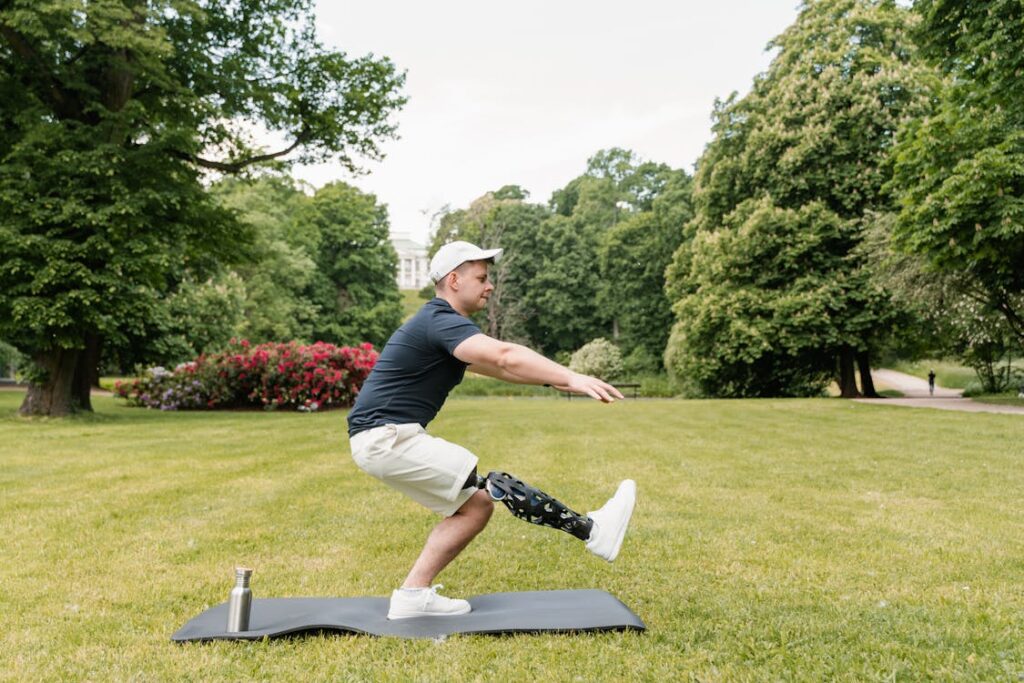
Conclusion
Pressure points in lower limb prosthetics may seem small at first, but they can quickly grow into serious setbacks if ignored. The key to preventing skin breakdown lies in staying aware, acting early, and never accepting discomfort as “normal.”
A well-fitting socket, clean liners, balanced gait, and regular skin checks are your strongest tools. Pair that with consistent follow-ups and good habits, and you can stay ahead of pressure-related problems before they start.
Your skin is your first line of defense—and protecting it means more freedom, more movement, and more confidence in everyday life. Every small step you take to care for it adds up to a better, more comfortable prosthetic experience.



